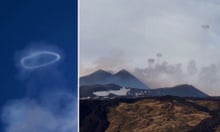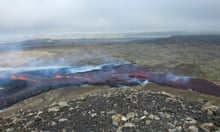Australian travellers heading to and from the Indonesian resort island of Bali face another day of disruption as airlines closely monitor the ash cloud from the Mount Agung volcano.
Scientists say Mount Agung’s volcanic activity could escalate further over the coming days, meaning planes could stay grounded with thousands unable to fly in or out of Bali. Denpasar Airport remains closed.
The normally bustling airport was a ghost town on Monday night, speckled with confused tourists left stranded by the cancellation of flights because of volcanic ash.
Earlier, Indonesia raised its alert for the Mount Agung volcano to the highest level, warning of the “imminent” risk of a larger eruption.
Some travellers had retired on Monday night on makeshift beds on the terminal’s dusty floors. Others were considering a more than 10-hour journey across land to Surabaya to begin a string of flights across Indonesia and eventually to Australia.
But all were frustrated by the lack of information from the airlines. The first Janeen McKay heard of the cancellations was a text from her brother in Australia just before she arrived at the airport.
“I had nothing from Jetstar, they had my mobile number,” she said.
She had been waiting for nearly 12 hours and was told by the airline she couldn’t get home until Saturday.
McKay, an office manager, said she needed to get back to Geraldton to take care of her elderly mother, while her sister, Wendy Lynch, needed to be at work as a nurse on Thursday.
“We had a really nice time in Bali but then we get here and this has just ruined it,” McKay said. “Why does it take five days to get us out of here? Not very happy.”
Quick GuideMount Agung eruption
Show

Where is the volcano?
Mount Agung rises about 3,000m above Bali's Karangasem district, in the island's east. Bali lies within the so-called Pacific ring of fire, an area of high seismic and volcanic activity where thousands of tremors occur each year.
Has it erupted before?
Mount Agung's last major eruption in 1963 killed about 1,100 people and razed many villages. More than 50,000 Indonesians were evacuated in September this year when experts warned an eruption was imminent. About 25,000 people have been unable to return to their homes since then.
What is happening this time?
21 November – a minor eruption sent a plume of ash and steam rising about 700m. Volcanologists said it was caused by magma heating water (phreatic eruption). No alert was issued.
25 November – three minor eruptions sent a plume rising 4,000m and coated nearby villages in a layer of ash. An exclusion zone of 7.5km was put in place and some flights were diverted or cancelled.
26 November – Indonesia's Volcano Observatory Notice for Aviation updated to code red, predicting a further eruption with significant volcanic ash. Some flights were cancelled. Experts said the eruption was being driven by magma rather than steam.
27 November – Indonesian authorities raised the alert to the highest level and ordered people within 10km to leave as experts warned of an imminent risk of a larger eruption. Australia's Bureau of Meteorology said the ash plume had risen to 9,144m. Denpasar airport was closed for 24 hours.
How long will it last?
Australia's BOM expects eruptions and ash to continue for at least 24 hours. Indonesian government volcanologist Gede Suantika estimates Agung could spew ash for at least a month.
Veronika Naberezhnova said she was resigned to waiting too. “It’s a bit annoying,” the Department of Human Services employee said. “My family’s waiting there [in Sydney] as well, they’re all waiting, they’re all stressed.”
On the other side of the island, at Sanur beach, a gentle crackling of lightning and afternoon rain was the only annoyance to tourists lounging on sun beds and sipping cocktails.
For most, the airport’s closure had resulted in an extended holiday.
“What’s to be annoyed about getting stuck here?” asked Simon Allan, whose flight to Perth was cancelled because of the ash cloud billowing out of the mountain nearly 70km north.
His partner Deborah Flynn said she too was unfazed. “We have no control of nature and we’ll just go with the moment and see what happens tomorrow,” she said.
Many hotels had offered guests who had flights cancelled free or discounted accommodation. A representative from Tauzia hotels, which has nearly 20 sites on Bali, said they needed to encourage tourists to visit.
She said the threat of Mount Agung’s eruption had resulted in the tropical island’s quietest two months in years.
“To make sure our guests who want to travel to Bali feel safe, we have a commitment that we are giving a free night,” Anggun Jenniari said.
Q&AHow have you been affected by the Bali volcano evacuation?
Show
If you have been affected by the events in Bali you can tell us about it using our encrypted form, or by sending your pictures and videos to the
Guardian securely via WhatsApp by adding the contact +44(0)7867825056.
We will feature some of your contributions in our reporting.
Your safety is most important, so please ensure that you’re taking this into account when recording or sharing your content.
Jetstar on Tuesday morning cancelled all flights to and from Bali and said it would reassess the situation at 4pm.
Virgin Australia cancelled all flights between Bali and Australia on Tuesday.
Jetstar acknowledged “further disruptions are possible this week depending on weather conditions”.
Affected Jetstar customers have been given the option of flying to destinations including Phuket, Singapore, Fiji or Tokyo at no additional cost.
Other major airlines were monitoring the situation but were unable to fly until the massive ash cloud dissipated.
Indonesia’s Volcano Observatory Notice for Aviation remains at the highest red rating – indicating a further eruption with significant emission of volcanic ash into the atmosphere is imminent.








